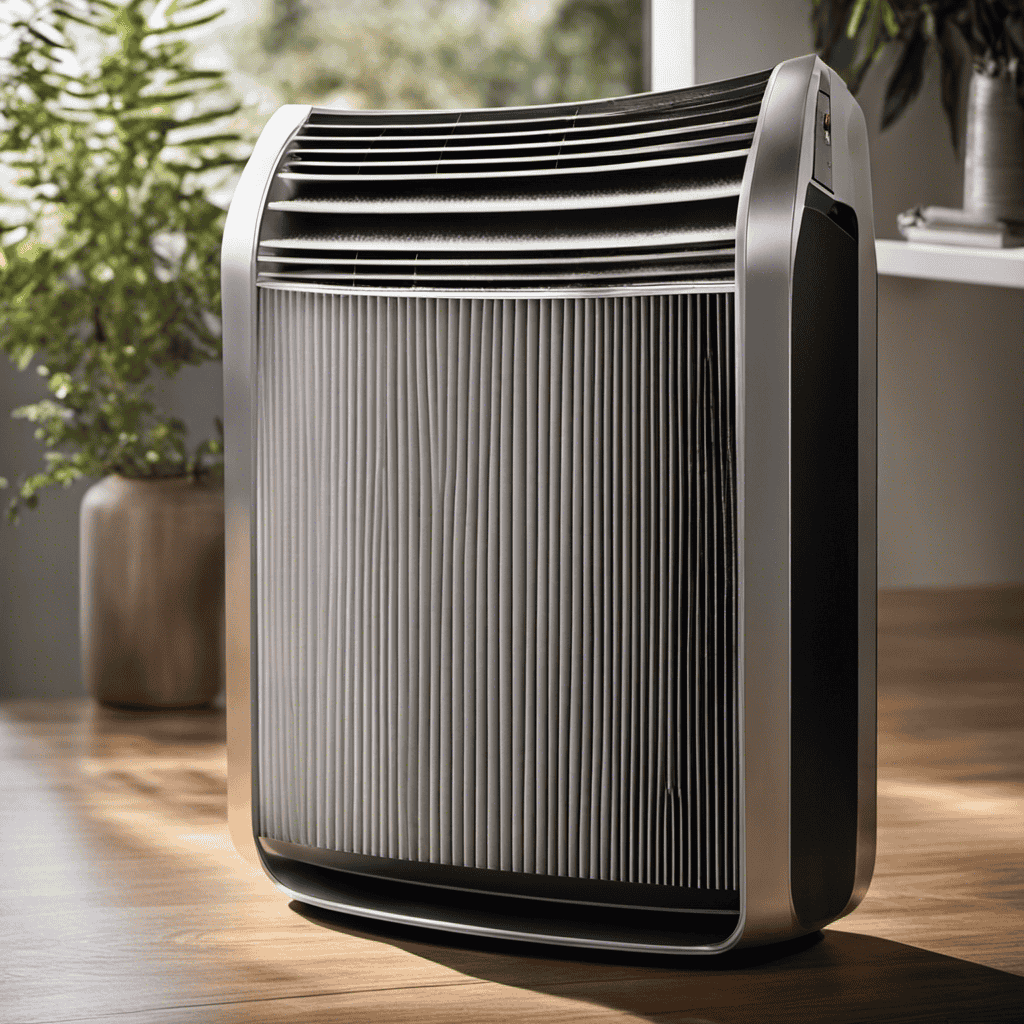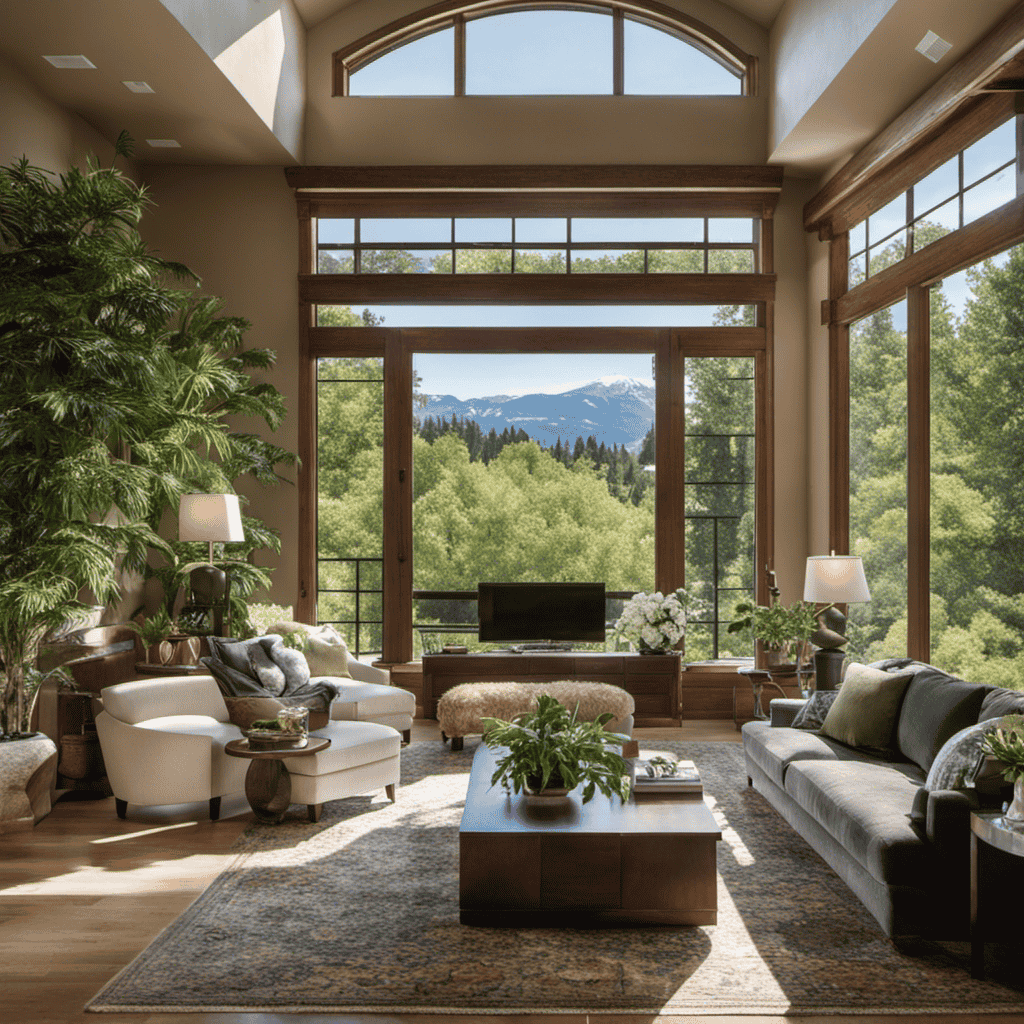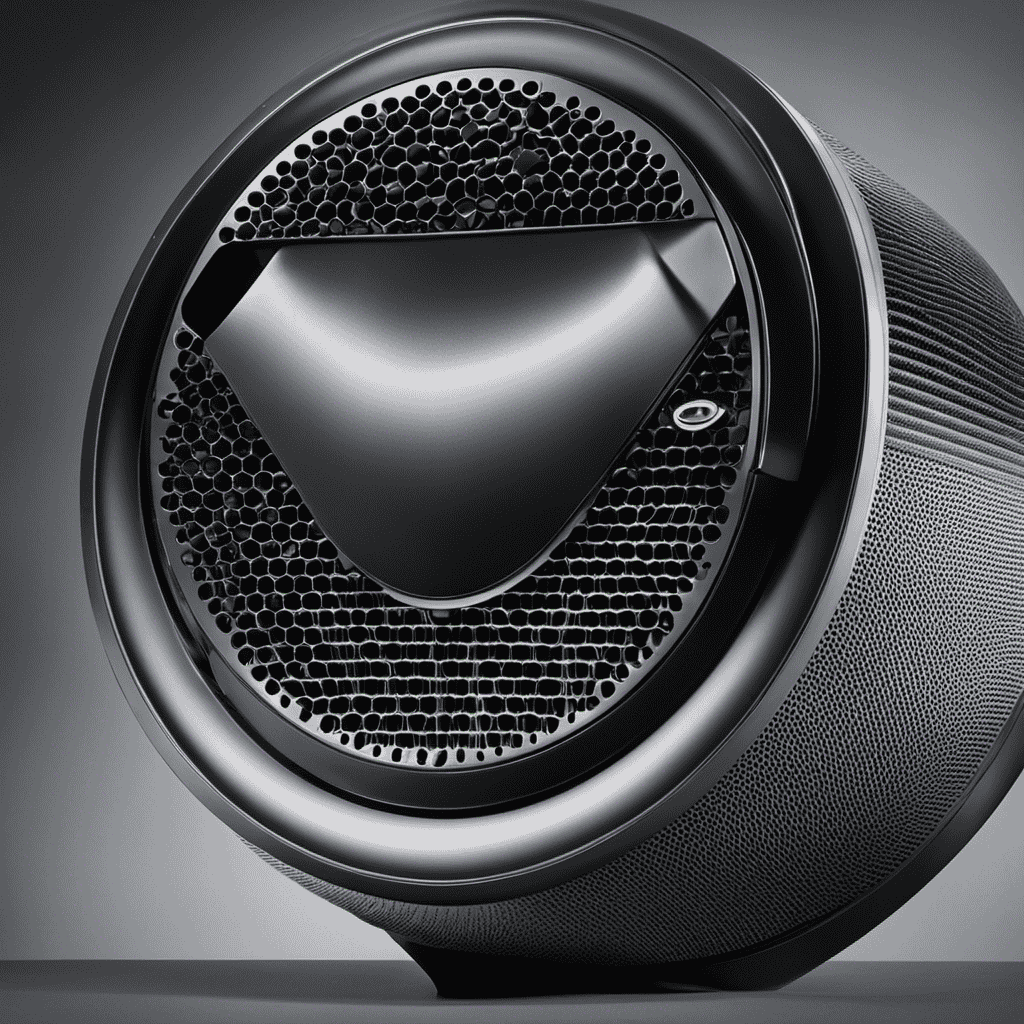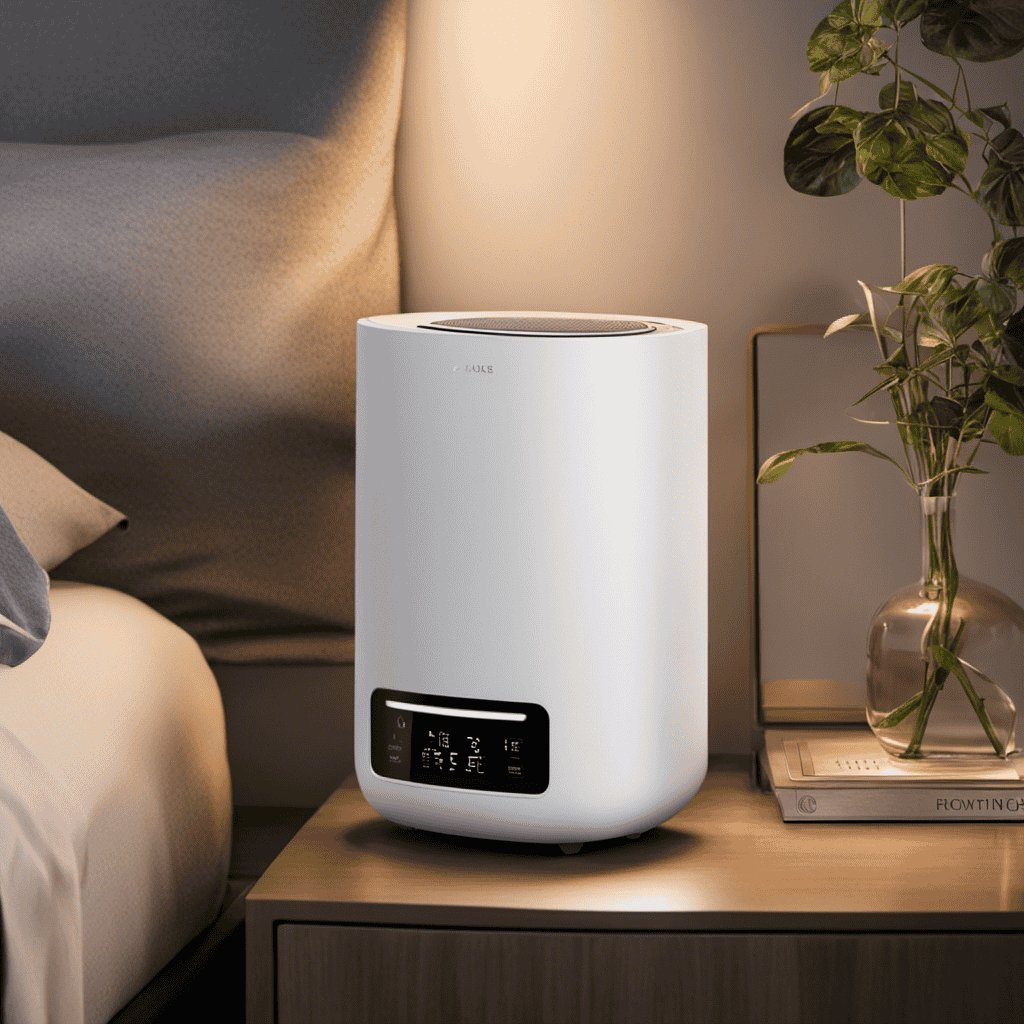I used to frequently forget to change the filter in my air purifier. It may have seemed like a minor task, but I was unaware of the impact it was having on the air quality I was breathing in.
That’s why I’ve done my research and learned the importance of regular filter changes. In this article, I’ll share with you everything I’ve discovered about how often you should change the filter in your air purifier, so you can breathe easy and keep your air clean.
Key Takeaways
- The frequency of filter changes depends on factors such as the quality of air in the environment, cleanliness of the filter, and the level of pollutants present.
- Regular filter changes are important for improving air quality, reducing allergens and pollutants, and maintaining the effectiveness of the air purifier.
- Different types of filters have varying lifespans, ranging from a few months to a year, and regular maintenance such as cleaning and washing can help extend their lifespan.
- Best practices for filter maintenance and replacement include regularly checking the filter for dirt and debris, following manufacturer’s recommendations, using a pre-filter, and avoiding harsh cleaning agents.
Factors Affecting Filter Lifespan
One of the factors that affects the lifespan of an air purifier’s filter is the quality of the air in your environment. The recommended filter maintenance for air purifiers typically includes regular cleaning or replacement. This is because the cleanliness of the filter directly impacts the air quality in your space. When the filter becomes dirty and clogged with particles, it becomes less effective at trapping and removing pollutants from the air. As a result, the air purifier may not be able to perform optimally, leading to reduced air quality and potential health risks.
Regularly cleaning or replacing the filter is crucial to maintain the efficiency and effectiveness of your air purifier. It is important to follow the manufacturer’s guidelines regarding filter maintenance, as different models may have varying recommendations. Some filters may need to be cleaned or replaced every few months, while others may last up to a year. Factors such as the level of pollutants in your environment, the size of the filter, and the speed at which the air purifier operates can also influence how often you need to change the filter.
In summary, the cleanliness of the filter directly impacts the air quality in your space. Regular filter maintenance, whether through cleaning or replacement, is essential to ensure that your air purifier can effectively remove pollutants from the air.
Now, let’s delve into the importance of regular filter changes.
The Importance of Regular Filter Changes
Maintaining clean air in your home is crucial, and regularly replacing the filter in your air purifier is key. Not only does it help improve the air quality, but it also provides numerous health benefits for you and your family. By changing your air purifier filter regularly, you can reduce the presence of allergens, dust, pet dander, and other pollutants in your home, ultimately improving your respiratory health and reducing the risk of allergies and asthma attacks.
Regularly replacing your air purifier filter also helps extend the lifespan of your device, ensuring that it continues to function optimally. It prevents the filter from becoming clogged and inefficient, which can lead to higher energy consumption and increased wear and tear on the purifier.
To convey the importance of regular filter changes in a more comprehensive way, here is a table that summarizes the health benefits and cost-effective solutions associated with frequent filter replacements:
| Health Benefits | Cost-Effective Solutions |
|---|---|
| Improved air quality | Longer lifespan of air purifier |
| Reduced allergens and pollutants | Lower energy consumption |
| Enhanced respiratory health | Reduced maintenance costs |
Understanding Your Air Purifier’s Filter Indicator
Understanding how your air purifier’s filter indicator works is essential for ensuring that your indoor air remains clean and healthy. The filter indicator serves as a helpful reminder to change your air purifier’s filter regularly, as part of proper air purifier maintenance.
Here are three key things to know about your air purifier’s filter indicator:
-
Functionality: The filter indicator is designed to monitor the efficiency of your air purifier’s filter. It measures the amount of particles and pollutants that the filter has captured over time. Once the filter reaches its maximum capacity, the indicator will alert you that it’s time to replace the filter.
-
Timing: The filter indicator takes into account the specific model and usage of your air purifier. It calculates the optimal time for filter replacement based on factors such as the air quality in your area and the level of pollutants in your home. This ensures that you change the filter at the right time for maximum efficiency.
-
Importance: Regularly changing your air purifier’s filter is crucial for maintaining its effectiveness in cleaning the air in your home. A clogged or dirty filter can hinder the airflow and reduce the filter’s efficiency in capturing airborne particles and allergens. By paying attention to the filter indicator, you can ensure that your air purifier continues to provide clean and healthy indoor air.
Recommended Filter Change Frequency for Different Models
When it comes to maintaining the air quality in your home, understanding the recommended filter change frequency for your specific air purifier model is essential. Model-specific filter replacement ensures that your air purifier operates at its optimal level, effectively removing pollutants from the air.
Factors such as the type of pollutants in your environment, the frequency of use, and the quality of the filter itself can all affect the lifespan of your filter. Therefore, it is important to consider these factors in order to determine the optimal filter change interval for your air purifier.
Model-Specific Filter Replacement
It’s important to check the manufacturer’s guidelines for the recommended frequency of filter replacement for your specific air purifier model. Each model has its own unique maintenance requirements to ensure optimal performance and longevity of the filters.
Here are some key points to consider for model-specific filter replacement:
- Refer to the user manual or manufacturer’s website for the recommended filter change interval.
- Some models have filter replacement indicators that will alert you when it’s time to change the filters.
- Certain air purifiers may have different types of filters that require different replacement frequencies.
- Regularly cleaning and maintaining your air purifier can increase filter efficiency and extend their lifespan.
By following the manufacturer’s recommendations and properly maintaining your air purifier, you can ensure that your filters are replaced at the appropriate intervals, allowing your purifier to effectively clean the air in your home.
Now let’s explore the factors that can affect the lifespan of air purifier filters.
Factors Affecting Filter Lifespan
To maximize the lifespan of your air purifier filters, regularly cleaning and maintaining your unit is essential. Properly maintaining your air purifier filters is crucial to ensure their efficiency and effectiveness in removing airborne contaminants.
There are several recommended filter maintenance practices that can help prolong the lifespan of your filters. Firstly, vacuuming or gently brushing the exterior of the filter can remove any dust or debris that may have accumulated. Additionally, washing or replacing pre-filters regularly can prevent clogging and improve the overall performance of your filters.
Factors that can impact filter efficiency include the air quality in your environment, the frequency of use, and the type of contaminants present. High levels of pollutants or frequent use may require more frequent filter replacements.
Optimal Filter Change Interval
Regularly assessing the condition of your filters and considering factors such as air quality and usage patterns will help determine the optimal interval for changing them.
There are several factors that can influence the optimal change frequency of your air purifier filter:
- Air quality: If you live in an area with high pollution levels or have pets, your filter may need to be changed more frequently.
- Usage patterns: If you run your air purifier for extended periods of time or on high settings, the filter may become clogged faster.
- Filter type: Different types of filters have varying lifespans, so it’s important to follow the manufacturer’s guidelines.
To maximize the lifespan of your filter, here are a few tips:
- Vacuum or dust the exterior of the filter regularly to remove any debris.
- Use a pre-filter to capture larger particles and extend the life of the main filter.
- Keep your air purifier in a clean environment to prevent unnecessary dirt buildup.
By following these tips and considering the factors influencing optimal change frequency, you can ensure that your air purifier filter lasts as long as possible.
In the next section, we will discuss the signs that it’s time to change your air purifier filter.
Signs That It’s Time to Change Your Air Purifier Filter
As an expert in air purifiers, I want to discuss the importance of filter replacement indicators and the health impacts of neglecting to change your air purifier filter.
Filter replacement indicators are a crucial feature that alerts users when it’s time to replace the filter based on usage and air quality.
Neglecting to change the filter can lead to decreased air purifying efficiency and can potentially harm your health by allowing pollutants and allergens to circulate in the air.
It is essential to understand the significance of these indicators and prioritize regular filter replacements for optimal air quality and well-being.
Filter Replacement Indicators
Make sure you check if your air purifier has filter replacement indicators. These indicators are an essential feature that can help you keep track of when it’s time to change your air purifier filter. Here are three reasons why filter replacement indicators are important:
-
Efficiency: Filter performance can be affected by various factors, such as the air quality in your home and the presence of pets or smokers. Filter replacement indicators take these factors into account and provide you with accurate information on when your filter needs to be changed to maintain optimal performance.
-
Convenience: With filter replacement indicators, you don’t have to guess or rely on a fixed schedule to change your filter. The indicators will alert you when it’s time for a replacement, saving you time and effort.
-
Cost savings: Changing your air purifier filter at the right time ensures that it is working efficiently. By using filter replacement indicators, you can avoid premature filter replacements, which can save you money in the long run.
Health Impacts of Neglecting
Neglecting to change the filters in your air purifier can have a significant impact on your respiratory system, especially if you suffer from allergies or asthma. When the filters become dirty and clogged, they are less effective at capturing and removing allergens, such as pollen, dust mites, and pet dander, from the air.
This can lead to an increase in allergy symptoms, including sneezing, itching, and congestion. For individuals with asthma, neglected filters can worsen symptoms and trigger asthma attacks. The accumulation of dust and other particles in the air can irritate the airways, leading to coughing, wheezing, and difficulty breathing.
Regularly changing the filters in your air purifier is crucial to maintain clean and healthy indoor air, reducing the risk of respiratory issues and improving overall well-being.
Extending the Lifespan of Your Air Purifier Filter
To extend the lifespan of your air purifier filter, you should regularly clean it and replace it as needed. This will help maintain filter efficiency and prolong filter effectiveness.
Here are some tips to help you keep your air purifier filter in top shape:
-
Clean the pre-filter: Many air purifiers have a pre-filter that captures larger particles like dust and pet hair. Cleaning this pre-filter regularly will prevent it from getting clogged and allow it to work more effectively in capturing smaller particles.
-
Vacuum the filter: Use a vacuum cleaner with a brush attachment to gently remove dust and debris from the filter. This will help maintain its airflow and prevent it from becoming clogged.
-
Check the filter indicator: Some air purifiers have a filter indicator that tells you when it’s time to replace the filter. Pay attention to this indicator and replace the filter accordingly to ensure optimal performance.
How to Properly Clean and Maintain Your Air Purifier Filter
Now that we’ve discussed how to extend the lifespan of your air purifier filter, let’s delve into how to properly clean and maintain it.
By implementing effective cleaning techniques, you can ensure that your air purifier filter performs optimally and lasts longer.
One common problem with air purifier filters is dust accumulation. Over time, dust particles can clog the filter and reduce its efficiency. To combat this, it’s essential to regularly clean your filter. The frequency of cleaning will depend on various factors such as the air quality in your area and the usage of your air purifier. However, a general guideline is to clean the filter every two to three months.
To clean your air purifier filter, start by turning off the device and unplugging it from the power source. Remove the filter from the unit and gently tap it to dislodge any loose particles. Next, use a soft brush or vacuum with a brush attachment to remove any remaining debris. If the filter is washable, rinse it under running water until all dirt and dust are removed. Allow the filter to air dry completely before reinstalling it.
Another common problem with air purifier filters is odor accumulation. If you notice any unpleasant smells coming from your filter, you can try using odor-eliminating sprays or placing odor-absorbing materials near the air purifier.
Different Types of Air Purifier Filters and Their Lifespan
If you want to understand the lifespan of different types of air purifier filters, it’s important to familiarize yourself with the various options available.
There are several types of air purifier filters, each with its own unique features and lifespan. Here are the most common types of air purifier filters and their approximate lifespan:
-
Pre-Filter: This is the first line of defense for your air purifier, capturing large particles like dust and pet hair. It is usually washable and can last up to 3 months with regular cleaning.
-
HEPA Filter: High-Efficiency Particulate Air (HEPA) filters are the gold standard in air purification. They can remove up to 99.97% of particles as small as 0.3 microns. HEPA filters typically last between 6 months to 1 year, depending on usage and the air quality in your environment.
-
Carbon Filter: These filters are effective at removing odors, gases, and volatile organic compounds (VOCs). They usually last between 3 to 6 months, depending on the level of pollutants in your indoor air.
-
Electrostatic Filter: These filters use an electric charge to attract and trap particles. They are washable and can last up to 6 months with proper maintenance.
It’s important to note that the lifespan of a filter also depends on factors like filter maintenance and filter efficiency. Regularly cleaning or replacing your filters will ensure optimal performance and clean air in your home.
The Impact of Air Quality on Filter Replacement Frequency
When it comes to air purifier filters, there are several factors that can affect their replacement frequency. Factors such as the air quality in your area, the size of your living space, and the type of filter you are using can all play a role in how often you should replace your filter.
Timely replacement of air purifier filters comes with numerous benefits, including improved air quality, reduced allergens and pollutants, and increased energy efficiency.
Additionally, there are ways to extend the lifespan of your air purifier filter. Regular cleaning and maintenance, ensuring proper ventilation, and avoiding activities that introduce excessive particles into the air can all help in this regard.
Factors Affecting Replacement Frequency
The factors that affect how often you should change the filter in an air purifier include the air quality in your home and the amount of dust and allergens present. Maintaining filter efficiency is crucial for optimal air purification. Here are some key factors to consider:
-
Air Quality:
-
Presence of pollutants like smoke, pet dander, or chemicals
-
Geographic location and outdoor air quality
-
Seasonal variations in air pollution
-
Dust and Allergens:
-
High levels of dust due to construction or renovations
-
Allergy sufferers in the household
-
Pets shedding fur or dander
-
Best Practices for Filter Maintenance:
-
Regularly check the filter for dirt and debris
-
Follow the manufacturer’s recommendations for filter replacement
-
Consider using a filter replacement indicator to ensure timely changes
Benefits of Timely Replacement
Now that we understand the factors that can affect the frequency of filter replacement in our air purifier, let’s discuss the benefits of timely replacement.
One of the main cost benefits of changing the filter regularly is maintaining the efficiency of the air purifier. A clogged or dirty filter can reduce the purifier’s effectiveness, forcing it to work harder and use more energy to clean the air. By replacing the filter on time, we can ensure that the purifier is working efficiently, saving us money on energy costs in the long run.
In addition to cost benefits, timely filter replacement also has long-term effects on our health. A clean filter helps remove pollutants, allergens, and other harmful particles from the air, making it cleaner and healthier to breathe. By regularly replacing the filter, we can maintain good indoor air quality, which is crucial for our overall well-being.
Extending Filter Lifespan
To extend the lifespan of your filter, it’s important to regularly clean it and remove any accumulated dust or debris. This not only increases filter efficiency but also reduces the need for frequent filter maintenance. Here are some tips to help you maximize the lifespan of your filter:
- Clean the filter at least once a month by gently vacuuming or rinsing it with water.
- Use a soft brush to remove stubborn dirt or debris.
- Allow the filter to dry completely before reinstalling it.
Consider using a pre-filter to trap larger particles and protect the main filter. Avoid using harsh cleaning agents or chemicals that can damage the filter material. Keep the surrounding area clean to prevent additional dust from accumulating on the filter.
Following these steps will not only help extend the lifespan of your filter but also ensure that it functions at its best, providing you with cleaner and healthier air.
Common Misconceptions About Air Purifier Filters
Don’t let yourself fall for the misconception that air purifier filters only need to be changed once a year. Proper maintenance and regular filter changes are essential for the optimal performance of your air purifier. There are several common misconceptions about air purifier filters that need to be debunked to ensure you are taking the best care of your device.
One misconception is that filters only need to be changed when they appear dirty. In reality, waiting until your filter is visibly dirty can significantly impact the effectiveness of your air purifier. Another misconception is that all filters have the same lifespan. Different types of filters, such as HEPA, activated carbon, and pre-filters, have varying lifespans and should be replaced accordingly.
To help you better understand the maintenance needs of your air purifier, here is a table highlighting the recommended filter change intervals for common filter types:
| Filter Type | Recommended Change Interval |
|---|---|
| HEPA Filter | Every 6 to 12 months |
| Activated Carbon Filter | Every 6 months |
| Pre-filter | Every 3 to 6 months |
DIY Vs. Professional Filter Replacement: Which Is Better
Hiring a professional for filter replacement may be more convenient, but DIY filter replacement can save you money. While it is true that professionals have the expertise and tools to efficiently replace air purifier filters, there are several reasons why you should consider doing it yourself:
-
Cost Comparison:
-
Professional filter replacement services can be expensive, especially when you factor in the cost of labor and travel fees.
-
DIY filter replacement allows you to purchase filters at a lower cost and save on service charges.
-
Filter Replacement Efficiency:
-
When you replace the filters yourself, you have the opportunity to choose high-quality filters that meet your specific needs.
-
DIY filter replacement ensures that you can maintain the efficiency of your air purifier by replacing the filters promptly.
-
Flexibility and Convenience:
-
DIY filter replacement allows you to replace the filters at your convenience, without having to schedule an appointment with a professional.
-
You can easily monitor the condition of your filters and replace them whenever necessary, ensuring that your air purifier is always functioning optimally.
Making Filter Changes a Part of Your Air Purifier Routine
Making filter changes a regular part of my air purifier maintenance routine has been crucial in ensuring its continued effective functioning. Regularly changing the filters helps to keep the air in my home clean and free from harmful particles.
One of the signs that indicate it’s time to change the filters is a decrease in the air purifier’s performance. If I notice that the air purifier is not removing as many allergens or odors as before, it could be a sign that the filters are clogged and need to be replaced. Another sign is an increase in dust or dirt around the air purifier. This can indicate that the filters are no longer able to trap particles effectively and are in need of a change.
When troubleshooting filter issues, it’s important to first check the manufacturer’s guidelines for the recommended filter replacement schedule. Different air purifiers have different requirements, and following these guidelines will help maintain optimal performance. Additionally, inspecting the filters regularly and cleaning or replacing them as needed can prevent any potential issues.
Regular filter changes not only improve the air quality in my home but also prolong the life of my air purifier. By incorporating filter changes into my maintenance routine, I can ensure that my air purifier continues to function effectively and provide me with clean, fresh air.
Frequently Asked Questions
Can an Air Purifier Function Without a Filter?
An air purifier cannot function effectively without a filter. The filter plays a crucial role in removing pollutants and improving air quality. Without a filter, the air purifier would not be able to trap dust, pet dander, pollen, and other harmful particles.
The impact of filter quality on air purifier performance is significant. A high-quality filter can efficiently capture more pollutants and provide better overall air purification. Therefore, using a filter in an air purifier has numerous benefits.
Can I Clean and Reuse My Air Purifier Filter?
I can’t believe it! I thought I could clean and reuse my air purifier filter indefinitely. Turns out, it’s not such a great idea.
The lifespan of an air purifier filter is limited, and it’s important to replace it regularly. By doing so, you can ensure that your air purifier is functioning optimally and effectively removing pollutants from the air.
Plus, a fresh filter means cleaner, healthier air for you and your family.
How Do I Know if My Air Purifier Filter Needs to Be Changed?
To determine if your air purifier filter needs to be changed, there are a few signs to look out for.
Firstly, a decrease in air flow or weak performance from the purifier could indicate a clogged filter.
Additionally, if you notice an increase in dust or allergens in your home, it’s a good indication that the filter needs replacing.
To extend the lifespan of your air purifier filter, regular cleaning and maintenance is key.
Can I Use a Different Brand of Filter in My Air Purifier?
Can I use a different brand of filter in my air purifier? Absolutely! Using generic filters in air purifiers is a common practice.
However, it’s important to consider compatibility. Not all brands may fit perfectly or provide the same level of filtration. I recommend checking the specifications of your air purifier and ensuring that the new filter meets the requirements.
Additionally, using an incompatible filter may affect the performance and efficiency of your air purifier.
Is It Necessary to Change the Pre-Filter and Carbon Filter as Often as the HEPA Filter?
It’s important to consider the maintenance needs of different filters in an air purifier.
While the HEPA filter is typically recommended to be changed every 6-12 months, the pre-filter and carbon filter may not need to be replaced as frequently.
The lifespan of the pre-filter and carbon filter can vary based on the specific model and usage.
Regular cleaning and maintenance can help extend the lifespan of these filters, so it’s essential to follow the manufacturer’s instructions for pre-filter maintenance and carbon filter replacement.
What Are the Benefits of Regularly Changing the Filter on an Air Purifier?
Regular air purifier filter change frequency is crucial for maintaining clean indoor air quality. By regularly changing the filter on an air purifier, you can ensure that it continues to effectively remove pollutants, allergens, and other harmful particles from the air, ultimately benefiting your respiratory health.
Conclusion
In conclusion, understanding the importance of regular filter changes in your air purifier is crucial for maintaining clean and healthy indoor air.
Just like a vigilant gatekeeper, the filter acts as a shield, protecting you from harmful pollutants.
By regularly replacing the filter, you ensure that your air purifier continues to function at its best, effectively removing allergens and contaminants.
So, don’t neglect this essential task!
Make filter changes a routine part of your air purifier maintenance, and breathe in the freshness and purity that your space deserves.










